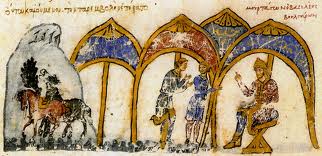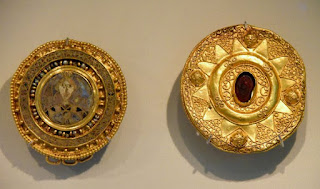Roger Scott, Byzantine Chronicles and the Sixth Century
Review from BMCR
In this recent addition to the Variorum Collected Studies Series, Roger Scott grapples with Byzantine historiography and the age of Justinian. The papers contained therein are divided into four broad groupings: (A) Historiography, Chronicle and the Sixth Century; (B) Malalas, Theophanes and the Sixth Century; (C) Malalas, Theophanes and Their Byzantine Past; and (D) Reinterpreting the Fifth and Sixth Centuries. Scott, a Classicist by training, has devoted a good part of his career to the study of early Byzantine chronicles, with a particular emphasis on Malalas and Theophanes.1 Like other volumes in this series, the majority of the papers included were originally published elsewhere. Some of these come from hard to find publications such as Bysantinska Sälskapet Bulletin, a boon for scholars who might otherwise lack access to them. Some of the articles are over forty years old (X). On the other hand, two of the nineteen are published for the first time in this volume.
-->
The first section (A) is composed of six papers that deal, by and large, with the character of early and high Byzantine chronicles. Scott discusses the length of chronicles (I) and notes their reliance on earlier documents. He discusses "the ubiquity of good stories in Byzantine culture" (I, p. 34), such as the story of the apple of Theodosius II and the eagle of Marcian (IV), he describes the development of Byzantine historiography (III); and he treats "the literariness of Byzantine historical writing" (V). In the last paper of the section (VI), a new one, Scott returns to an earlier thesis, arguing that Malalas, for all his faults, is representative of his age and is to be applauded for including details not found elsewhere. At the same time, Procopius is not to be trusted, at least with regard to what he chooses to emphasize (war), and how he interprets the reign of Justinian. In the end, Scott, unsurprisingly (given what he has written before) claims that we ought not see "Justinian as the great conqueror and restorer of the Empire".
The second section (B) contains seven papers and focuses on the sixth century. We return to what constituted the most important events of Justinian's reign, and how the texts of Malalas and Theophanes as well as those of authors like John the Lydian (X) have been and should be used to evaluate the reign. While discussing the reliability of Theophanes' Chronicle as a source for Justinianic events, Scott argues that there is much to be gained from exploring Theophanes' impact on Byzantine historiography (and literature in general) (XII). As in the book as a whole, Malalas is the focus of the majority of the papers in this section. Malalas, we read, approached history in a manner in keeping with the worldview of his contemporaries, while presenting an interpretation of the past and present all his own (VII). Malalas' Chronicle is replete with official dispatches, at least when he turns to contemporary or near-contemporary events (VIII). This includes the Roman Empire's diplomatic dealings (XI). Yet, Malalas and Procopius, despite their ostensible differences in mentalité, often agree on certain facts about Justinian's reign (such as Justinian's gifts of money to barbarians), though Malalas draws upon Justinianic propaganda to present them in a positive light while Procopius presents them negatively in his Secret History (IX). The final paper of the section explores the different ways that Malalas and Theophanes interpret the reign of Justinian while downplaying the importance of Procopius.
Click here to read the rest of the review
In this recent addition to the Variorum Collected Studies Series, Roger Scott grapples with Byzantine historiography and the age of Justinian. The papers contained therein are divided into four broad groupings: (A) Historiography, Chronicle and the Sixth Century; (B) Malalas, Theophanes and the Sixth Century; (C) Malalas, Theophanes and Their Byzantine Past; and (D) Reinterpreting the Fifth and Sixth Centuries. Scott, a Classicist by training, has devoted a good part of his career to the study of early Byzantine chronicles, with a particular emphasis on Malalas and Theophanes.1 Like other volumes in this series, the majority of the papers included were originally published elsewhere. Some of these come from hard to find publications such as Bysantinska Sälskapet Bulletin, a boon for scholars who might otherwise lack access to them. Some of the articles are over forty years old (X). On the other hand, two of the nineteen are published for the first time in this volume.
-->
The first section (A) is composed of six papers that deal, by and large, with the character of early and high Byzantine chronicles. Scott discusses the length of chronicles (I) and notes their reliance on earlier documents. He discusses "the ubiquity of good stories in Byzantine culture" (I, p. 34), such as the story of the apple of Theodosius II and the eagle of Marcian (IV), he describes the development of Byzantine historiography (III); and he treats "the literariness of Byzantine historical writing" (V). In the last paper of the section (VI), a new one, Scott returns to an earlier thesis, arguing that Malalas, for all his faults, is representative of his age and is to be applauded for including details not found elsewhere. At the same time, Procopius is not to be trusted, at least with regard to what he chooses to emphasize (war), and how he interprets the reign of Justinian. In the end, Scott, unsurprisingly (given what he has written before) claims that we ought not see "Justinian as the great conqueror and restorer of the Empire".
The second section (B) contains seven papers and focuses on the sixth century. We return to what constituted the most important events of Justinian's reign, and how the texts of Malalas and Theophanes as well as those of authors like John the Lydian (X) have been and should be used to evaluate the reign. While discussing the reliability of Theophanes' Chronicle as a source for Justinianic events, Scott argues that there is much to be gained from exploring Theophanes' impact on Byzantine historiography (and literature in general) (XII). As in the book as a whole, Malalas is the focus of the majority of the papers in this section. Malalas, we read, approached history in a manner in keeping with the worldview of his contemporaries, while presenting an interpretation of the past and present all his own (VII). Malalas' Chronicle is replete with official dispatches, at least when he turns to contemporary or near-contemporary events (VIII). This includes the Roman Empire's diplomatic dealings (XI). Yet, Malalas and Procopius, despite their ostensible differences in mentalité, often agree on certain facts about Justinian's reign (such as Justinian's gifts of money to barbarians), though Malalas draws upon Justinianic propaganda to present them in a positive light while Procopius presents them negatively in his Secret History (IX). The final paper of the section explores the different ways that Malalas and Theophanes interpret the reign of Justinian while downplaying the importance of Procopius.
Click here to read the rest of the review




Comments
Post a Comment